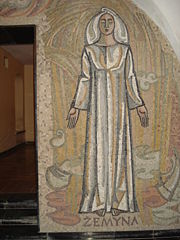
Žemyna
Encyclopedia

Lithuanian mythology
Lithuanian mythology is an example of Baltic mythology, developed by Lithuanians throughout the centuries.-History of scholarship:Surviving information about Baltic paganism in general is very sketchy and incomplete. As with most ancient Indo-European cultures Lithuanian mythology is an example of...
. She is usually regarded as mother goddess
Mother goddess
Mother goddess is a term used to refer to a goddess who represents motherhood, fertility, creation or embodies the bounty of the Earth. When equated with the Earth or the natural world such goddesses are sometimes referred to as Mother Earth or as the Earth Mother.Many different goddesses have...
and one of the chief Lithuanian gods similar to Latvian
Latvian mythology
Latvian culture, along with Lithuanian, is among the oldest surviving Indo-European cultures. Much of its symbolism is ancient. Its seasons, festivals, and numerous deities reflect the essential agrarian nature of Latvian tribal life...
Zemes māte
Zeme
Zeme, also referred to as Zemes-mãte, was a Slavic and Latvian goddess of the earth, identical to Lithuanian Žemyna. Her name means "Mother of the Earth." She had a total of seventy sisters, some related specifically to the function of fertility....
. Žemyna personifies the fertile earth and nourishes all life on earth, human, plant, and animal. All that is born of earth will return to earth, thus her cult is also related to death. As the cult diminished after baptism of Lithuania, Žemyna's image and functions became influenced by the cult of Virgin Mary.
Žemyna was first mentioned by Jan Łasicki
Jan Łasicki
Jan Łasicki was a Polish historian and theologian. He was well-educated and traveled extensively in Western Europe from 1556 to 1581. Around 1557 he converted Calvinism, becoming a follower of the Unity of the Brethren after 1567....
(1582). It was later also described by Mikalojus Daukša
Mikalojus Daukša
Mikalojus Daukša was a Lithuanian and Latin religious writer, translator and a Catholic church official...
(1595), Daniel Klein
Daniel Klein (grammarian)
Daniel Klein was a Lutheran pastor and scholar from Tilsit, Duchy of Prussia, who is best known for writing the first grammar book of the Lithuanian language.Klein studied philosophy, theology, Greek and Hebrew in the University of Königsberg...
(1653), Matthäus Prätorius
Matthäus Prätorius
Matthäus Prätorius was a Protestant pastor, later a Roman Catholic priest, a historian and ethnographer....
, Jacob Brodowski (1740), and in numerous folk legends, beliefs, and prayers. Prätorius described a ritual, called žemyneliauti, performed at major celebrations (e.g. weddings) or agricultural works (e.g. harvest). The head of the household would drink a cup of beer, but first he would spill some of the drink on the ground and say a short prayer. Then he would kill a rooster or a hen, which would be cooked and eaten by the entire family. Each family member would receive a loaf of bread and say prayers, blessings, and greetings. The bones and other scraps would be sacrificed to the goddess (burned or buried). Other recorded rites included burying bread baked from last crops of prior harvest in a field before new sowing and sacrifice of black piglet. People would also kiss the earth saying a short prayer thanking Žemyna for all her gifts and acknowledging that one day they will return to her. People addressed Žemyna in various affectionate diminutive
Diminutive
In language structure, a diminutive, or diminutive form , is a formation of a word used to convey a slight degree of the root meaning, smallness of the object or quality named, encapsulation, intimacy, or endearment...
names and epithet
Epithet
An epithet or byname is a descriptive term accompanying or occurring in place of a name and having entered common usage. It has various shades of meaning when applied to seemingly real or fictitious people, divinities, objects, and binomial nomenclature. It is also a descriptive title...
s.
The goddess is said to be married to either Perkūnas
Perkunas
Perkūnas was the common Baltic god of thunder, one of the most important deities in the Baltic pantheon. In both Lithuanian and Latvian mythology, he is documented as the god of thunder, rain, mountains, oak trees and the sky.-Etymology:...
(thunder god) or Praamžius (manifestation of chief heavenly god Dievas
Dievas
Lithuanian Dievas, Latvian Dievs, Prussian Deywis, Yotvingian Deivas was the supreme god in the Baltic mythology and one of the most important deities together with Perkūnas. Dievas is a direct successor of the Proto-Indo-European supreme god *Dyēus of the root *deiwo-...
). Thus the couple formed the typical Indo-European
Proto-Indo-European religion
Proto-Indo-European religion is the hypothesized religion of the Proto-Indo-European peoples based on the existence of similarities among the deities, religious practices and mythologies of the Indo-European peoples. Reconstruction of the hypotheses below is based on linguistic evidence using the...
pair of mother-earth and father-sky. It was believed that the earth needs to be fertilized by the heavens (rain and thunder). Thus is was prohibited to plow or sow before the first thunder as the earth would be barren.

